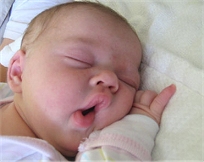|
 |
|
Volume 8 |
~ News From
"Your Birthing
Family" ~ |
Issue 4 |
| |
_______________________________________________ |
|
|
About Babies
Co-Sleeping a SIDS Danger?
By Dr.
William Sears
January 9, 2012

Q. I've heard that sharing a bed with your baby poses a
danger for SIDS. Is this true? We've been co-sleeping with our 3-month-old since
he was born, and I'm worried that I could be putting him in danger. A.
Don't worry; continue co-sleeping. Because I have thoroughly researched
this common concern and written two books on the subject, The Baby Sleep
Book and SIDS: A Parent's Guide to Understanding and Preventing Sudden Infant
Death Syndrome, I feel that I can confidently advise you on this subject.
In the SIDS book, you'll find more than 250 scientific references to support the
information provided on sleep and breathing patterns, and safe sleeping
arrangements.
Also, my wife and I co-slept with every one of our eight babies and I have
advocated the practice throughout my 35 years of being a pediatrician.
I've come to the conclusion that co-sleeping, if practiced wisely and safely,
can actually lower the risk of SIDS, and here's why:
Co-sleeping helps your baby rouse himself: New research
has shown that in most cases, SIDS is caused by a baby's inability to arouse
himself from sleep. Normally, when something occurs that threatens your
baby's well being, such as difficulty breathing, he will automatically wake up.
For reasons that are still unknown, in some babies, this protective mechanism
does not go off, and so these babies are more at risk for SIDS.
This is where the positive aspects of co-sleeping come in. Dr. James
McKenna, director of the Mother-Baby Sleep Laboratory and Professor of
Anthropology at the University of Notre Dame, has conducted numerous studies of
mothers and babies who were co-sleeping and night nursing. His group of
researchers found that mom and baby share similar patterns of sleep arousals,
what we call "nighttime harmony." They drifted in and out of sleep stages
in a similar, but not always identical, pattern. Some SIDS researchers
believe that this is a factor in baby's protective arousal mechanism. This
harmony may also be related to a psychological synchronicity between co-sleeping
mothers and their babies: The co-sleeping mom is more likely to
subconsciously sense if her baby's health is in danger and wake up.
Researchers also believe that the carbon dioxide you exhale when you sleep close
to your baby may help stimulate her breathing. Plus, co-sleeping infants
tend to automatically sleep on their back, in order to have easier access to
nighttime feedings. Back sleeping has proved to be one of the top
risk-reducers for SIDS. Meanwhile, babies who sleep separately from their
moms have been shown to experience a decrease in the amount of REM sleep, the
state of sleep in which protective arousal is the most likely to occur.
Co-sleeping is a common practice worldwide: The rate of
SIDS is lowest in cultures that traditionally share sleep, such as Asian.
While there could be many other factors contributing to the lower incidence of
SIDS in these cultures, all the population studies I've seen have come to the
same conclusion: Safe co-sleeping lowers the SIDS risk.
Co-sleeping warnings are based on imprecise science: I
began my pediatric career in academic medicine and teaching in university
hospitals. At that time, I learned an important lesson about scientific
research: When the conclusions of a scientific study and common sense
don't match, suspect faulty science. Both Dr. McKenna's writings and my
two books mentioned above contain information that proves the original studies
that triggered the "alarm" about co-sleeping were flawed.
In addition, scientists have yet to come to a universal agreement on the
definition of co-sleeping. I've always considered co-sleeping to mean
bed-sharing or sleeping within arm's reach of mother; however, it can also be
defined as simply being close to mom or sleeping in the parents' bedroom.
No matter your interpretation, you will find general agreement among all SIDS
researchers, pediatricians, and the American Academy of Pediatrics that sleeping
in the same room with parents lowers the risk of SIDS.
Co-sleeping is as safe as the conditions you practice: For obvious
reasons, parents under the influence of alcohol, drugs, or medications that
interfere with normal sleep patterns should never have their baby in their bed.
Other safeguards to employ:
Sleep in a king-size bed if possible, to give everybody enough room. Be
sure there are no wide crevices between the mattress and the guardrail or
headboard that your baby's head could sink into. Never allow infants to
sleep in the same bed with siblings or caregivers - they may not have the same
awareness of a baby's presence that parents do. Don't fall asleep with
your baby on a surface that isn't firm, such as a couch or a beanbag chair; she
could suffocate by getting wedged between the cushions.
Many parents have resolved co-sleeping worries by using a bedside co-sleeper:
a crib-like bed that attaches securely to the side of your mattress. This
allows you to have your own sleeping space on your bed, while your baby sleeps
within arm's reach for easy nursing and comforting.
I hope you continue to enjoy co-sleeping with your baby, practice it safely, and
reap the rewards of feeling more connected with each other. Just remember
-- wherever you and your baby get the best night's sleep is the right
arrangement for your family.
Used with permission from the author

Co-Sleeping a SIDS Danger?
Dr. Sears, or Dr. Bill as his
"little patients" call him, is the father of eight children as well as
the author of over 30 books on childcare. Dr. Bill is an Associate
Clinical Professor of Pediatrics at the University of California,
Irvine, School of Medicine. Dr. Bill received his pediatric
training at Harvard Medical School's Children's Hospital in Boston and
The Hospital for Sick Children in Toronto -- the largest children’s
hospital in the world, where he served as associate ward chief of the
newborn nursery and associate professor of pediatrics. Dr. Sears
is a fellow of the American Academy of Pediatrics (AAP) and a fellow of
the Royal College of Pediatricians (RCP). Dr. Bill is also a medical and
parenting consultant for BabyTalk and Parenting magazines and the
pediatrician on the website
Parenting.com.
|

'Behold, I will bring them from the north country, And gather them
from the ends of the earth,
Among them the blind and the lame,
The woman with child and The one who labors with child, together,
A
great throng shall return there...And My people shall be satisfied with My goodness, says the LORD.'
Jeremiah 31:8, 14
~~~
©2013 Charis Childbirth
Services, All Rights Reserved
Feel free to forward this newsletter to friends in its entirety,
leaving all attribution intact.
April 2013
|
|